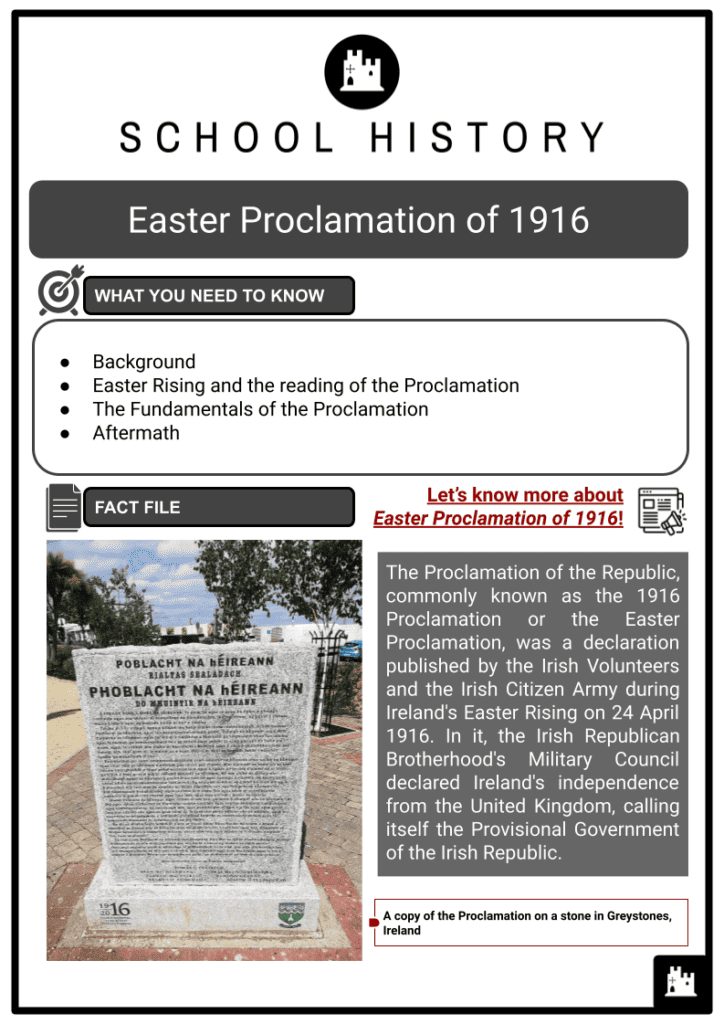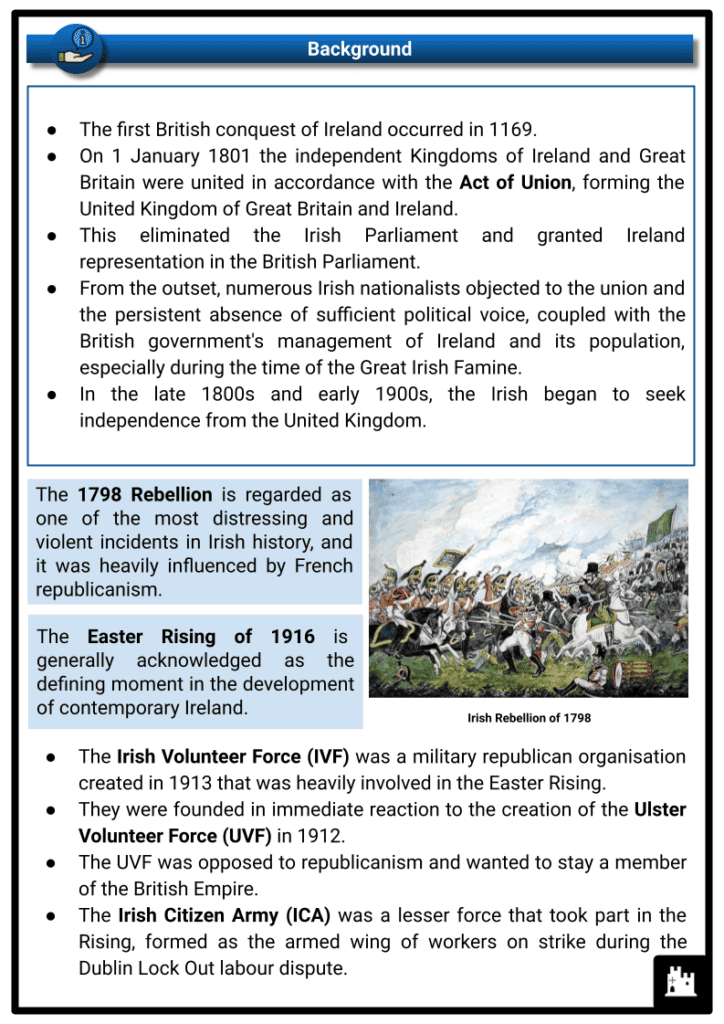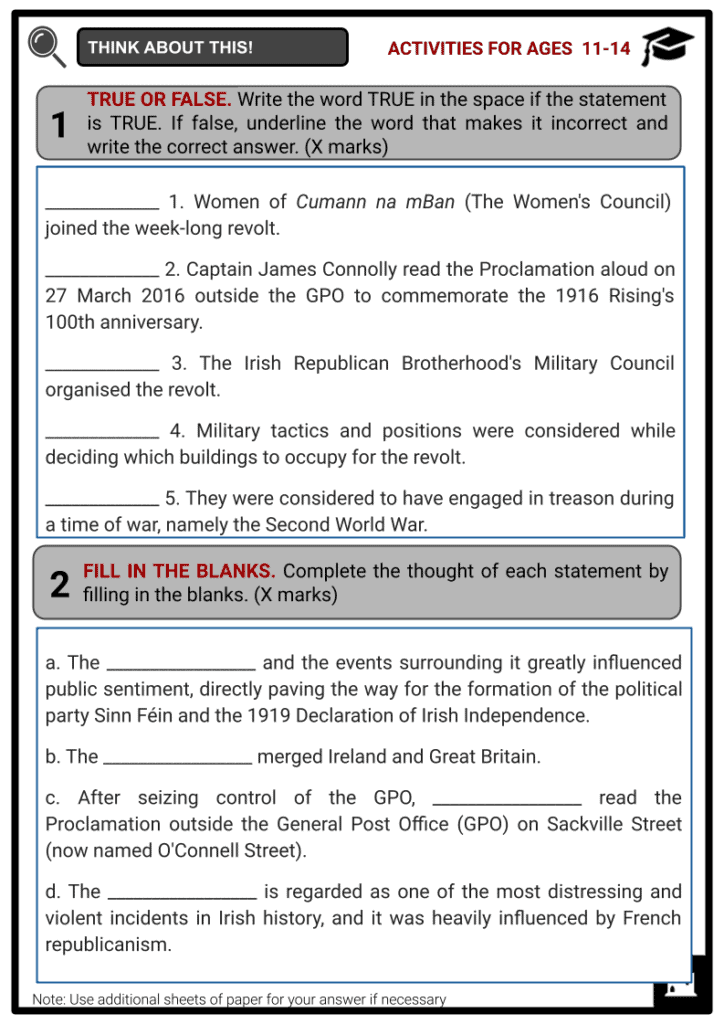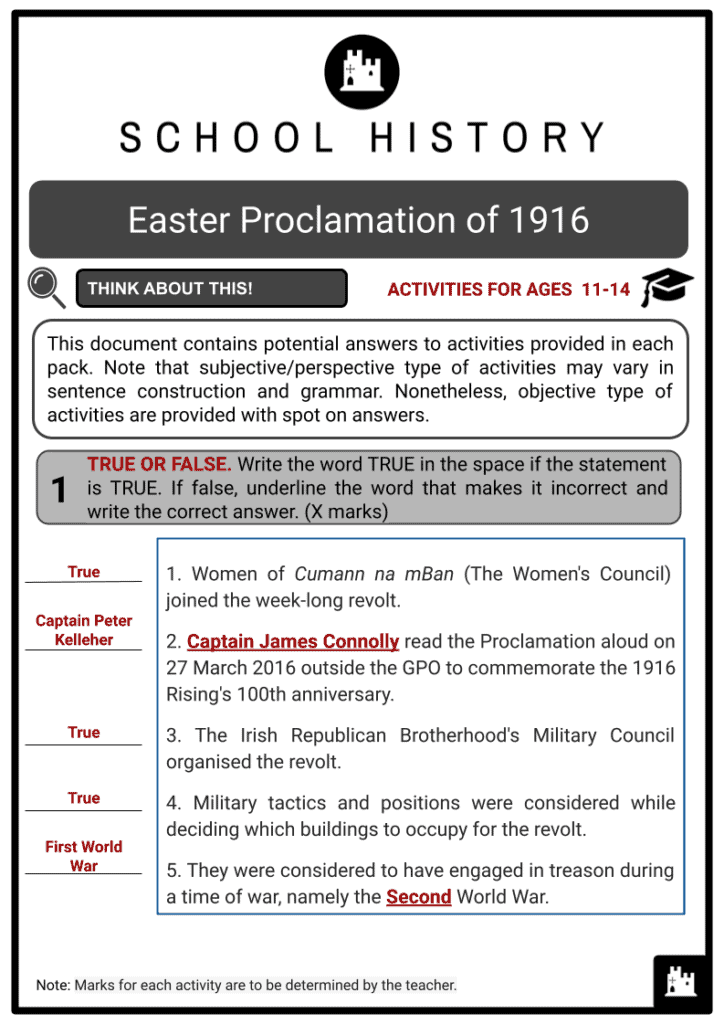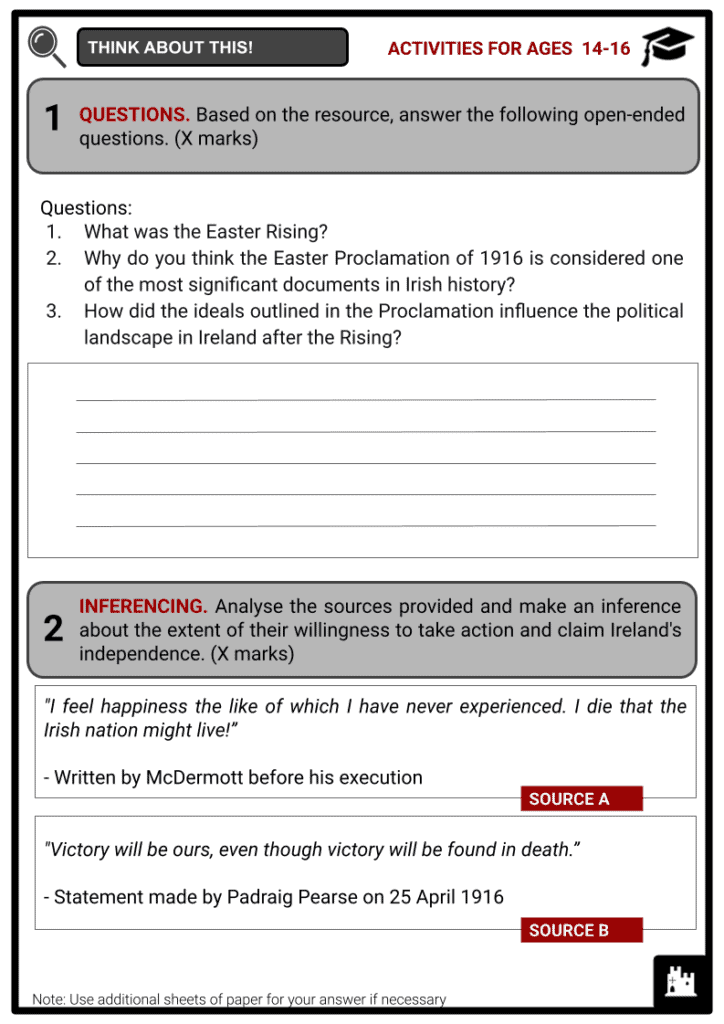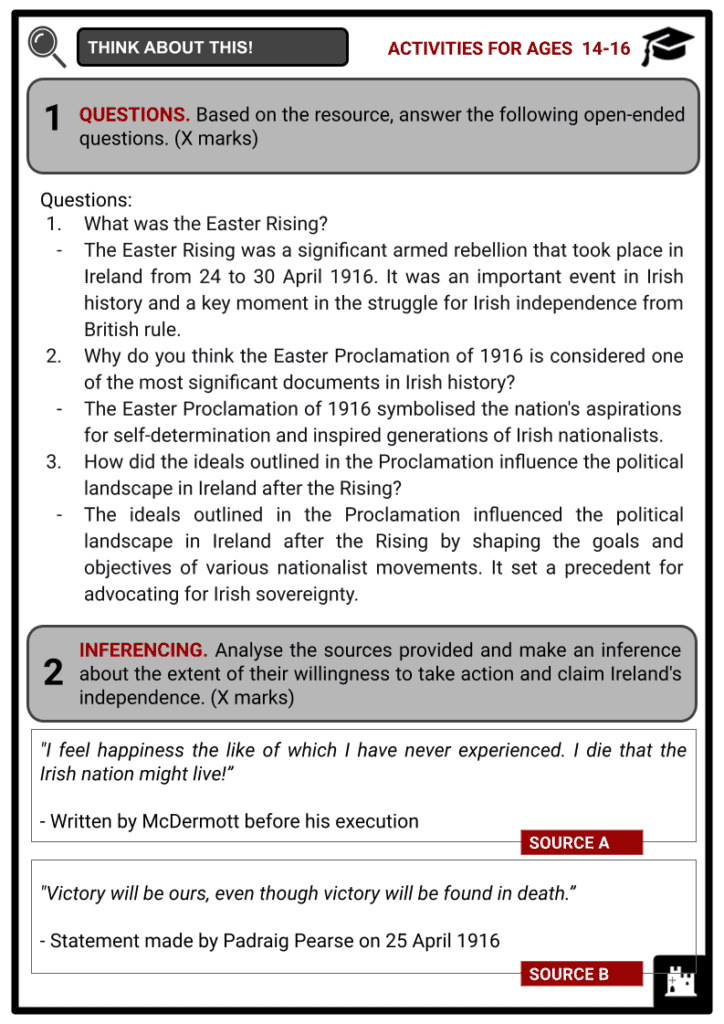Easter Proclamation of 1916 Worksheets
Do you want to save dozens of hours in time? Get your evenings and weekends back? Be able to teach about Easter Proclamation of 1916 to your students?
Our worksheet bundle includes a fact file and printable worksheets and student activities. Perfect for both the classroom and homeschooling!
Summary
- Background
- Easter Rising and the reading of the Proclamation
- The Fundamentals of the Proclamation
- Aftermath
Key Facts And Information
Let’s know more about Easter Proclamation of 1916!
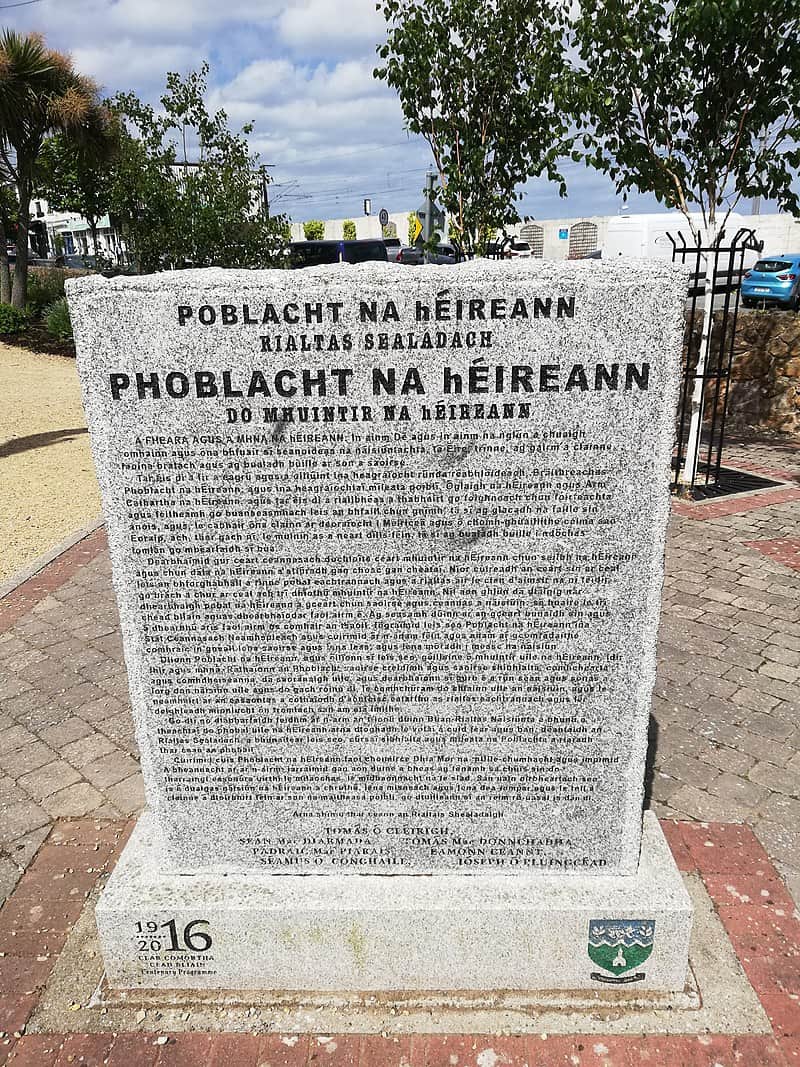
The Proclamation of the Republic, commonly known as the 1916 Proclamation or the Easter Proclamation, was a declaration published by the Irish Volunteers and the Irish Citizen Army during Ireland's Easter Rising on 24 April 1916. In it, the Irish Republican Brotherhood's Military Council declared Ireland's independence from the United Kingdom, calling itself the Provisional Government of the Irish Republic.
Background
- The first British conquest of Ireland occurred in 1169.
- On 1 January 1801 the independent Kingdoms of Ireland and Great Britain were united in accordance with the Act of Union, forming the United Kingdom of Great Britain and Ireland.
- This eliminated the Irish Parliament and granted Ireland representation in the British Parliament.
- From the outset, numerous Irish nationalists objected to the union and the persistent absence of sufficient political voice, coupled with the British government's management of Ireland and its population, especially during the time of the Great Irish Famine.
- In the late 1800s and early 1900s, the Irish began to seek independence from the United Kingdom.
- The 1798 Rebellion is regarded as one of the most distressing and violent incidents in Irish history, and it was heavily influenced by French republicanism.
- The Easter Rising of 1916 is generally acknowledged as the defining moment in the development of contemporary Ireland.
- The Irish Volunteer Force (IVF) was a military republican organisation created in 1913 that was heavily involved in the Easter Rising.
- They were founded in immediate reaction to the creation of the Ulster Volunteer Force (UVF) in 1912.
- The UVF was opposed to republicanism and wanted to stay a member of the British Empire.
- The Irish Citizen Army (ICA) was a lesser force that took part in the Rising, formed as the armed wing of workers on strike during the Dublin Lock Out labour dispute.
Easter Rising and the reading of the Proclamation
- The Easter Rising of 1916 demonstrated a willingness to use violence to establish Ireland as a republic.
- At that time, the British were preoccupied with the difficulties of World War One. Although conscription was never enforced in Ireland, over 200,000 Irishmen enlisted in the British army throughout the war. Members of the UVF were eager to fight for their nation, but many IVF members were unwilling to defend a country that they did not want to be a part of.
- The Irish Republican Brotherhood's Military Council organised the revolt.
- It started on Easter Monday, 24 April 1916, and lasted six days.
- Members of the Irish Volunteers, commanded by schoolmaster and Irish activist Padraig Pearse and joined by James Connolly's smaller Irish Citizen Army and 200 women of Cumann na mBan (The Women's Council), seized strategically significant buildings in Dublin and proclaimed the Irish Republic.
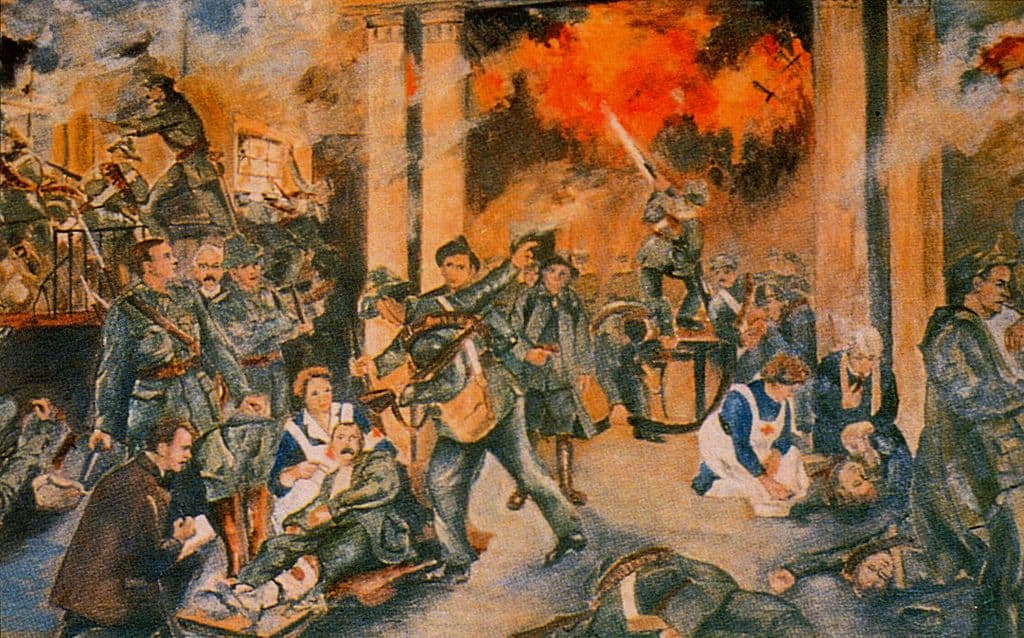
Attack at the General Post Office in Dublin - The Irish Volunteer Force, Irish Citizen Army, and IRB members took control of the pre-selected buildings in Dublin marking the start of the Rising. The South Dublin Union, the General Post Office, the Four Courts, Jacob's Factory, Boland's Mill, St Stephen's Green, and the College of Surgeons were among the structures. Both military strategy and location were considered when determining which buildings to occupy.
- A few individuals dressed in Irish Volunteer and Citizen Army attire, while others wore civilian clothes paired with a distinctive yellow Irish Volunteer armband, military headgear and bandoliers.
- After seizing control of the GPO, Padraig Pearse read the Proclamation outside the General Post Office (GPO) on Sackville Street (now named O'Connell Street).
- This was signed by James Connolly and six members of the IVF: Thomas J Clarke, Eamonn Ceannt, Thomas MacDonagh, Joseph Plunkett, Padraig Pearse and Sean MacDermott.
- It is beyond doubt that the Proclamation embodied the feelings of all seven members of the Military Council.
- Although the document's literary creation is thought to have been primarily the work of Pearse, it also displays traces of alteration and amendment by Connolly and possibly MacDonagh.
- The Proclamation's statement of a sovereign people's claims to social justice and control over the country's natural resources demonstrates Connolly's influence on the document's drafting.
- The final version of the Proclamation's four-page manuscript was entrusted to MacDonagh for safekeeping until Easter Sunday morning.
- It was handed over to Connolly, who had been assigned the task of getting it printed.
- Copies of the Proclamation were also affixed to walls and distributed by volunteers and newsboys to bystanders.
The Fundamentals of the Proclamation
- Although the Rising was a military failure, its guiding ideals had some degree of impact on how succeeding Irish politicians thought. The pamphlet contained a variety of claims, including:
- The leaders of the Rising claimed to speak for Ireland.
- The Rising signalled the beginning of a new wave of armed independence movements.
- The Irish Volunteers, Irish Citizen Army, and Irish Republican Brotherhood were crucial to the Rising.
- The people of Ireland's right to ownership of Ireland.
- A republican form of government was to be used.
- The first mention of gender equality, a guarantee of civil liberty, and equal rights and opportunities for all its residents... Irish women were not allowed to vote under British law.
- A commitment to universal suffrage without regard for gender, which was confined at the time to only a few countries and did not yet exist in the UK.
- A pledge to treat all of the nation's children equally. Although children's rights advocates have used these words since the 1990s, 'children of the nation' refers to all Irish people.
- The arguments between nationalists and unionists are said to come from variations deliberately encouraged by a foreign government, a refusal of what was later called the two-nations theory.
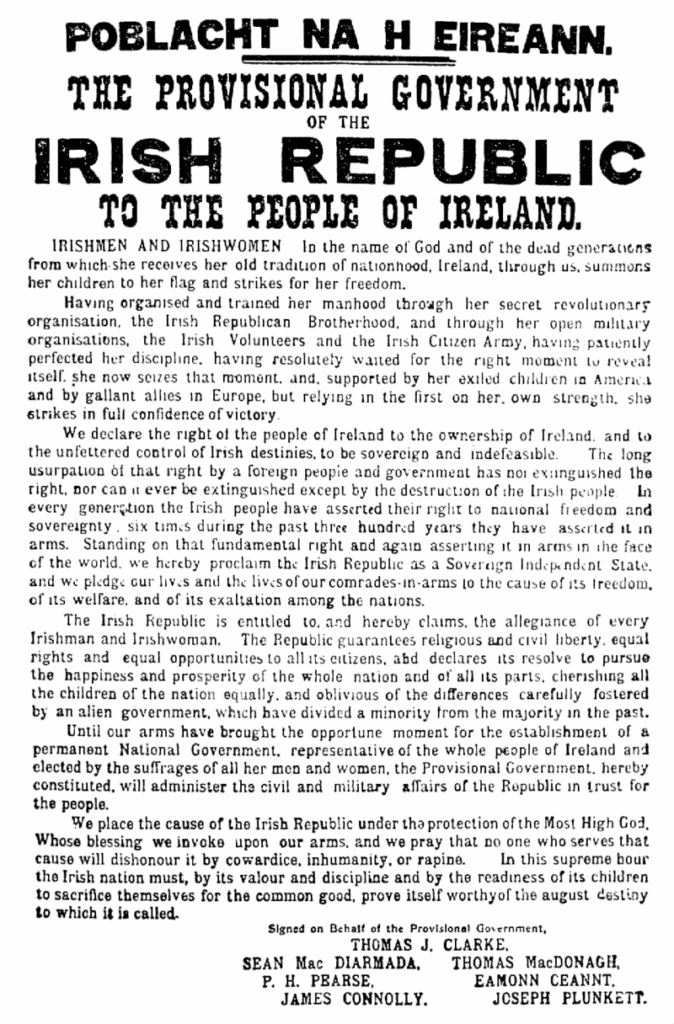
Copy of the original Proclamation
Aftermath
- By 28 April 1916, it became evident that their stay at the GPO could not be sustained much further.
- Pearse directed female volunteers to depart, and by 7pm, he himself was compelled to evacuate.
- At 8pm, the remaining insurgents assembled to sing Ireland's national anthem, The Soldier's Song.
- Following their surrender, the British took back control and 3,430 men and 79 women were apprehended.
- While approximately 2,700 prisoners were released by August 1916, the leaders found no means of escape.
- The British military executed 15 rebel leaders, including all seven individuals who had signed the Proclamation.
- They were considered to have engaged in treason during a time of war, namely the First World War.
- Initially, British political figures regarded these executions as ill-advised but later came to view them as a grave error.
- British Prime Minister HH Asquith, followed by Prime Minister David Lloyd George, expressed regret over permitting the British military to handle the matter as a military law issue during wartime rather than insisting that the leaders be tried under civilian criminal law.
- The Proclamation and the events surrounding it greatly influenced public sentiment, directly paving the way for the formation of the political party Sinn Féin and the 1919 Declaration of Irish Independence.
- On 27 March 2016, to commemorate the 1916 Rising's 100th anniversary, hundreds of thousands of people heard Captain Peter Kelleher read the Proclamation aloud outside the GPO. The Irish people are proud to honour what is arguably the most iconic scene in Irish history.
Frequently Asked Questions
- What is the Easter Proclamation of 1916?
The Easter Proclamation of 1916 was a document issued by the leaders of the Easter Rising in Ireland during April 1916. It declared Ireland's independence from British rule.
- Who wrote the Easter Proclamation?
The Easter Proclamation was primarily drafted by Patrick Pearse, with input from other leaders of the Irish Republican Brotherhood and the Irish Volunteers, including James Connolly and Thomas Clarke.
- What were the key principles outlined in the Easter Proclamation?
The Easter Proclamation affirmed the establishment of the Irish Republic, guaranteeing religious and civil liberty, equal rights, and opportunities for all citizens. It also called for establishing an Irish parliament and the right of the people to cherish all the nation's children equally.

